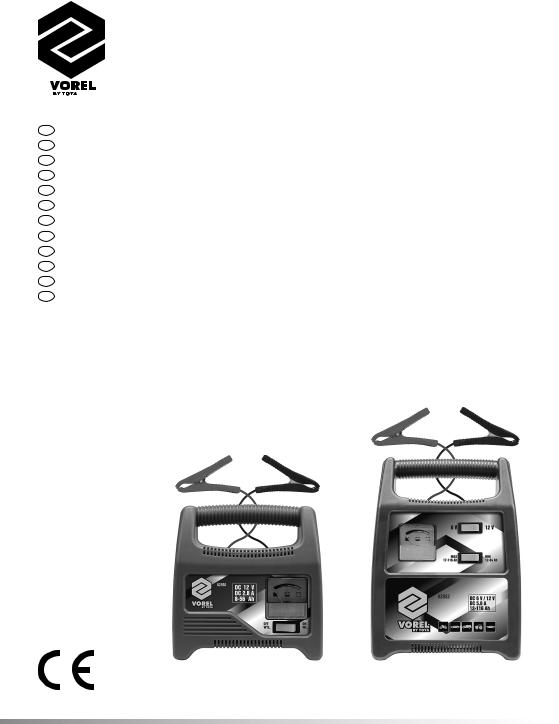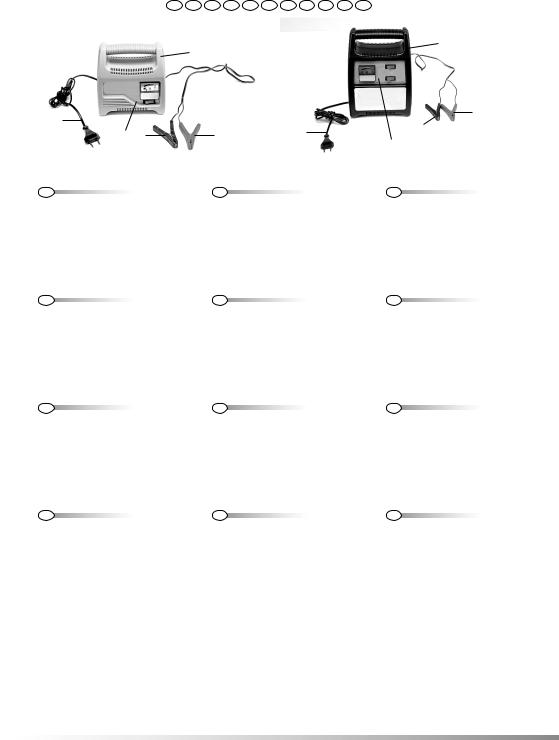VOREL 82550, 82551, 82552, 82553 User Manual

82550
82551
82552
82553
PL
GB DE RUS UA LT LV CZ SK HU RO E
PROSTOWNIK BATTERY CHARGER LADEGERÄT
ЗАРЯДНОЕ УСТРОЙСТВО ЗАРЯДНИЙ ПРИСТРІЙ
ĮKROVIKLIS
LĀDĒTĀJS
NABÍJEČKA
NABÍJAČKA
AKKUTÖLTŐ
REDRESOR RECTIFICADOR
82550 |
82552 |
82551 |
82553 |
I N S T R U K C J A O R Y G I N A L N A |
1 |
|
|

|
PL |
DE RUS UA LT LV CZ |
SK HU RO |
E |
|
|
|||
|
|
|
|
|
|
|
|
|
|
|
|
1 |
|
|
|
|
|
1 |
|
|
|
|
|
|
|
|
|
|
|
2 |
|
|
|
|
|
|
|
3 |
|
|
|
|
|
|
|
|
3 |
|
|
4 |
|
3 |
|
|
2 |
|
|
||
3 |
|
|
|
4 |
|
||||
|
|
|
|
|
|
|
|
|
|
|
|
|
|
|
|
|
|
|
|
|
|
|
82550, 82551 |
|
|
|
|
82552, 82553 |
|
PL |
|
|
GB |
|
DE |
||||
1. prostownik |
|
|
1. rectifier |
|
1. |
Ladegerät |
|||
2. przewód zasilający z wtyczką |
|
|
2. power supply cord with a plug |
2. |
Stromversorgungsleitung mit Stecker |
||||
3. przewód ładujący z zaciskiem |
|
|
3. charging cord with a terminal |
|
3. |
Leitung zum Laden mit Klemme |
|||
4. panel sterujący |
|
|
4. control panel |
|
4. |
Bedienpanel |
|||
RUS |
UA |
LT |
||
1. |
зарядное устройство (выпрямитель) |
1. |
зарядний пристрій |
1. įkroviklis |
2. |
питательный провод со штепселем |
2. |
провід живлення зі штепселем |
2. maitinimo laidas su kyštuku |
3. |
зарядной провод с зажимом |
3. |
провід живлення зі затиском |
3. krovimo laidas su gnybtu |
4. |
панель управления |
4. |
панель управління |
4. valdymo panelis |
LV |
CZ |
SK |
1. lādētājs |
1. nabíječka |
1. nabíjačka |
2. elektrības vads ar kontaktdakšu |
2. přívodní kabel se zástrčkou |
2. prívodný kábel so zástrčkou |
3. lādēšanas vads ar spaili |
3. nabíjecí vodič se svorkou |
3. nabíjací vodič so svorkou |
4. vadības panelis |
4. ovládací panel |
4. ovládací panel |
HU |
RO |
E |
1. akkumulátortöltő |
1. redresor |
1. rectificador |
2. hálózati kábel a dugasszal |
2. cablu de alimentare cu ştecher |
2. cable de alimentación con clavija |
3. töltő vezeték kapcsolóval |
3. cablu de încărcare cu borne |
3. conductor de carga con borne |
4. vezérlő panel |
4. panou de control |
4. panel de control |
2013 |
Rok produkcji: |
Produktionsjahr: |
Рік випуску: |
Ražošanas gads: |
Rok výroby: |
Anul producţiei utilajului: |
Production year: |
Год выпуска: |
Pagaminimo metai: |
Rok výroby: |
Gyártási év: |
Año de fabricación: |
TOYA S.A. ul. Sołtysowicka 13-15, 51-168 Wrocław, Polska
2 |
I N S T R U K C J A O R Y G I N A L N A |
|
|

Przeczytać instrukcję
Read the operating instruction Bedienungsanleitung durchgelesen
Прочитать инструкцию Прочитать iнструкцiю Perskaityti instrukciją Jālasa instrukciju Přečtet návod k použití Prečítať návod k obsluhe Olvasni utasítást
Citeşti instrucţunile Lea la instrucción
PL DE RUS UA LT LV CZ SK HU RO E
12 V 6 V/12 V
Napięcie znamionowe ładowania Nominal charging voltage Nennspannung zum Laden
Номинальное зарядное напряжение Номінальна напруга заряду
Nominali krovimo įtampa Nomināls uzlādēšanas spriegums Jmenovité nabíjecí napětí Menovité nabíjacie napätie Névleges töltési feszültség Tensiune nominală de încărcare La tensión nominal de carga
2,8 A 4,2 A 5,8 A 10,3 A
Prąd ładowania Charging current Ladestrom
Зарядный ток Струм заряду
Krovimo srovė Uzlādēšanas strāva Nabíjecí proud Nabíjací prúd Töltőáram
Curent de încărcare
La corriente eléctrica de carga
8 - 56 12 - 84 12 - 116 26 - 206 Ah Ah Ah Ah
Pojemność akumulatora Accumulator’s capacity Kapazität der Batterie
Ёмкость аккумулятора Ємкість акумулятора
Akumuliatoriaus talpa Akumulatora tilpums Kapacita akumulátoru Kapacita akumulátora
Az akkumulátor kapacitása Capacitate acumulator Capacidad del acumulador
WET
MOKRY
Rodzaj akumulatora Type of battery
Art des Akkumulators
Вид аккумулятора Вид акумулятора
Akumuliatoriaus tipas Akumulatora veids Typ akumulátoru Druh akumulátora
Az akkumulátor típusa Genul acumulatorului Tipo de acumulador
I N S T R U K C J A O R Y G I N A L N A |
3 |
|
|

PL DE RUS UA LT LV CZ SK HU RO E
OCHRONA ŚRODOWISKA
Symbol wskazujący na selektywne zbieranie zużytego sprzętu elektrycznego i elektronicznego. Zużyte urządzenia elektryczne sąsurowcami wtórnymi - nie wolno wyrzucać ich do pojemników na odpady domowe, ponieważ zawierają substancje niebezpieczne dla zdrowia ludzkiego i środowiska! Prosimy o aktywną pomoc w oszczędnym gospodarowaniu zasobami naturalnymi i ochronie środowiska naturalnego przez przekazanie zużytego urządzenia do punktu składowania zużytych urządzeń elektrycznych. Aby ograniczyć ilość usuwanych odpadów konieczne jest ich ponowne użycie, recykling lub odzysk w innej formie.
UMWELTSCHUTZ
Das Symbol verweist auf ein getrenntes Sammeln von verschlissenen elektrischen und elektronischen Ausrüstungen. Die verbrauchten elektrischen Geräte sind Sekundärrohstoffe – sie dürfen nicht in die Abfallbehälter für Haushalte geworfen werden, da sie gesundheitsund umweltschädigende Substanzen enthalten! Wir bitten um aktive Hilfe beim sparsamen Umgang mit Naturressourcen und dem Umweltschutz, in dem die verbrauchten Geräte zu einer Annahmestelle für solche elektrischen Geräte gebracht werden. Um die Menge der zu beseitigenden Abfälle zu begrenzen, ist ihr erneuter Gebrauch, Recycling oder Wiedergewinnung in anderer Form notwendig.
ОХРАНА ОКРУЖАЮЩЕЙ СРЕДЫ
Данный символ обозначает селективный сбор изношенной электрической и электронной аппаратуры. Изношенные электроустройства – вторичное сырье, в связи с чем запрещается выбрасывать их в корзины с бытовыми отходами, поскольку они содержат вещества, опасные для здоровья и окружающей среды! Мы обращаемся к Вам с просьбой об активной помощи в отрасли экономного использования природных ресурсов и охраны окружающей среды путем передачи изношенного устройства в соответствующий пункт хранения аппаратуры такого типа. Чтобы ограничить количество уничтожаемых отходов, необходимо обеспечить их вторичное употребление, рециклинг или другие формы возврата.
ОХОРОНА НАВКОЛИШНЬОГО СЕРЕДОВИЩА
Вказаний символ означає селективний збір спрацьованої електричної та електронної апаратури. Спрацьовані електропристрої є вторинною сировиною, у звязку з чим заборонено викидати їх у смітники з побутовими відходами, оскільки вони містять речовини, що загрожують здоровю та навколишньому середовищу! ЗвертаємосядоВасзпросьбоюстосовноактивноїдопомогиугалузіохоронинавколишньогосередовищатаекономноговикористанняприроднихресурсівшляхом передачі спрацьованих електропристроїв у відповідний пункт, що займається їх переховуванням. З метою обмеження обєму відходів, що знищуються, необхідно створити можливість для їх вторинного використання, рециклінгу або іншої форми повернення до промислового обігу.
APLINKOS APSAUGA
Simbolis nurodo, kad suvartoti elektroniniai ir elektriniai įrenginiai turi būti selektyviai surenkami. Suvartoti elektriniai įrankiai, – tai antrinės žaliavos – jų negalima išmesti į namųūkio atliekųkonteinerį, kadangi savo sudėtyje turi medžiagųpavojingųžmgaus sveikatai ir aplinkai! Kviečiame aktyviai bendradarbiauti ekonomiškame natūraliųišteklių tvarkyme perduodant netinkamą vartoti įrankį į suvartotų elektros įrenginių surinkimo punktą. Šalinamų atliekų kiekiui apriboti yra būtinas jų pakartotinis panaudojimas, reciklingas arba medžiagų atgavimas kitoje perdirbtoje formoje.
VIDES AIZSARDZĪBA
Simbols rāda izlietoto elektrisko un elektronisko iekārtu selektīvu savākšanu, Izlietotas elektriskas iekārtas ir otrreizējas izejvielas – nevar būt izmestas ar mājsaimniecības atkritumiem, jo satur substances, bīstamas cilvēku veselībai un videi! Lūdzam aktīvi palīdzēt saglabāt dabisku bagātību un sargāt vīdi, pasniegšot izlietoto iekārtu izlietotas elektriskas ierīces savākšanas punktā. Lai ierobežot atkritumu daudzumu, tiem jābūt vēlreiz izlietotiem, pārstrādātiem vai dabūtiem atpakaļ citā formā.
OCHRANA ŽIVOTNÍHO PROSTŘEDÍ
Symbol poukazuje na nutnost separovaného sběru opotřebovaných elektrických a elektronických zařízení. Opotřebovaná elektrická zařízení jsou zdrojem druhotných surovin – je zakázáno vyhazovat je do nádob na komunální odpad, jelikož obsahují látky nebezpečné lidskému zdraví a životnímu prostředí! Prosíme o aktivní pomoc při úsporném hospodaření s přírodními zdroji a ochraně životního prostředí tím, že odevzdáte použité zařízení do sběrného střediska použitých elektrických zařízení. Aby se omezilo množství odpadů, je nevyhnutné jejich opětovné využití, recyklace nebo jiná forma regenerace.
OCHRANA ŽIVOTNÉHO PROSTREDIA
Symbol poukazuje na nutnosť separovaného zberu opotrebovaných elektrických a elektronických zariadení. Opotrebované elektrické zariadenia sú zdrojom druhotných surovín – je zakázané vyhadzovať ich do kontejnerov na komunálny odpad, nakoľko obsahujú látky nebezpečné ľudskému zdraviu a životnému prostrediu! Prosíme o aktívnu pomoc pri hospodárení s prírodnými zdrojmi a pri ochrane životného prostredia tým, že opotrebované zariadenia odovzdáte do zberného strediska opotrebovaných elektrických zariadení. Aby sa obmedzilo množstvo odpadov, je nutné ich opätovné využitie, recyklácia alebo iné formy regenerácie.
KÖRNYEZETVÉDELEM
A használt elektromos és elektronikus eszközök szelektív gyűjtésére vonatkozó jelzés: A használt elektromos berendezések újrafelhasználható nyersanyagok – nem szabad őket a háztartási hulladékokkal kidobni, mivel az emberi egészségre és a környezetre veszélyes anyagokat tartalmaznak! Kérjük, hogy aktívan segítse a természeti forrásokkal való aktív gazdálkodást az elhasznált berendezéseknek a tönkrement elektromos berendezéseket gyűjtőpontra történőbeszállításával. Ahhoz, hogy a megsemmisítendő hulladékok mennyiségének csökkentése érdekében szükséges a berendezések ismételt vagy újra felhasználása, illetve azoknak más formában történő visszanyerése.
PROTEJAREA MEDIULUI
Simbolul adunării selective a utilajelor electrice şi electronice. Utilajele electrice uzate sunt materie primă repetată – este interzisă aruncarea lor la gunoi, deoarece conţin substanţe dăunătoare sănătăţii omeneşti cât dăunătoare mediului! Vărugăm deci săaveţi o atitudine activăîn ceace priveşte gospodărirea economicăa resurselor naturale şi protejarea mediului natural prin predarea utilajului uzat la punctul care se ocupă de asemenea utilaje electrice uzate. Pentru a limita cantităţile deşeurilor eliminate este necesară întrebuinţatrea lor din nou , prin recyklind sau recuperarea în altă formă.
PROTECCIÓN DEL MEDIO AMBIENTE
El símbolo que indica la recolección selectiva de los aparatos eléctricos y electrónicos usados. ¡Aparatos eléctricos y electrónicos usados son reciclados – se prohíbe tirarlos en contenedores de desechos domésticos, ya que contienen sustancias peligrosas para la salud humana y para el medio ambiente! Les pedimos su participación en la tarea de la protección y de los recursos naturales y del medio ambiente, llevando los aparatos usados a los puntos de almacenamiento de aparatos eléctricos usados. Con el fin de reducir la cantidad de los desechos, es menester utilizarlos de nuevo, reciclarlos o recuperarlos de otra manera.
4 |
I N S T R U K C J A O R Y G I N A L N A |
|
|

PL
CHARAKTERYSTYKA PRODUKTU
Prostownik jest urządzeniem umożliwiającym naładowanie różnego rodzaju akumulatorów. Prostownik przekształca prąd i napięcie obecne w sieci elektroenergetycznej, na takie, które pozawala bezpiecznie naładować akumulator. Dzięki ładowaniu łatwiej zapewnićwłaściwąpracęakumulatora, co znacząco wydłuża okres eksploatacji akumulatora. Prostownik umożliwia naładowanie tradycyjnych akumulatorów kwasowo - ołowiowych, tzw. akumulatorów mokrych.
Prawidłowa, niezawodna i bezpieczna praca narzędzia zależna jest od właściwej eksploatacji, dlatego:
Przed przystąpieniem do pracy z narzędziem należy przeczytać całą instrukcję i zachować ją.
Za szkody powstałe w wyniku nie przestrzegania przepisów bezpieczeństwa i zaleceń niniejszej instrukcji dostawca nie ponosi odpowiedzialności.
Wskaźniki zamontowane w obudowie urządzenia nie są miernikami w rozumieniu ustawy: „Prawo o pomiarach”
DANE TECHNICZNE
Parametr |
Jednostka miary |
|
|
Wartość |
|
|
Nr katalogowy |
|
82550 |
82551 |
|
82552 |
82553 |
Napięcie sieci |
[V a.c.] |
230 |
230 |
|
230 |
230 |
Częstotliwość sieci |
[Hz] |
50 |
50 |
|
50 |
50 |
Prąd sieci |
[A] |
0,24 |
0,37 |
|
0,56 |
1,02 |
Moc znamionowa |
[W] |
45 |
70 |
|
100 |
200 |
Napięcie znamionowe ładowania |
[V d.c.] |
12 |
12 |
|
6/12 |
6/12 |
Prąd ładowania |
[A] |
2,8 |
4,2 |
|
5,8 |
10,3 |
Pojemność akumulatora |
[Ah] |
8 - 56 |
12 - 84 |
|
12 - 116 |
26 - 206 |
Klasa izolacji |
|
II |
II |
|
II |
II |
Stopień ochrony |
|
IPX0 |
IPX0 |
|
IPX0 |
IPX0 |
Masa |
[kg] |
1,37 |
1,43 |
|
2,00 |
2,75 |
OGÓLNE WARUNKI BEZPIECZEŃSTWA
Urządzenie nie jest przeznaczony do użytku przez osoby (w tym dzieci) o obniżonej fizycznej, czuciowej lub umysłowej zdolności, także przez osoby z brakiem doświadczenia i wiedzy, chyba że sprawowany jest nad nimi nadzór albo zostały przeszkolone w zakresie obsługi urządzenia przez osoby odpowiedzialne za ich bezpieczeństwo.
Należy sprawować nadzór nad dziećmi, aby nie bawiły się urządzeniem.
Prostownik jest przeznaczony do ładowania tylko akumulatorów kwasowo ołowiowych. Ładowanie innego rodzaju akumulatorów może doprowadzić do porażenie elektrycznego niebezpiecznego dla zdrowia i życia.
Zabronione jest ładowanie baterii nie przeznaczonych do ponownego ładowania!
Podczas ładowania akumulator musi znajdować się w dobrze wentylowanym miejscu, zaleca się ładować akumulator w temperaturze pokojowej.
Prostownik jest przeznaczony do pracy wewnątrz pomieszczeń i zabronione jest wystawianie go na działanie wilgoci w tym opadów atmosferycznych.
Prostowniki posiadające I klasę izolacji elektrycznej musza być podłączane do gniazdek wyposażonych w przewód ochronny. W przypadku ładowania akumulatorów znajdujących się w instalacji elektrycznej samochodu należy najpierw zacisk prostownika podłączyćdo zacisku akumulatora, który nie jest podłączony do podwozia samochodu, następnie podłączyćdrugi zacisk prostownika do podwozia z dala od akumulatora i instalacji paliwowej. Następnie podłączyćwtyczkęprostownika do gniazda zasilającego. Po naładowaniu należy najpierw odłączyćwtyczkęprostownika od gniazda zasilającego, a następnie odłączyćzaciski prostownika. Nigdy nie pozostawiać prostownika podłączonego do sieci zasilającej. Zawsze wyciągać wtyczkę kabla zasilającego z gniazda sieciowego.
Należy przestrzegać oznaczeń biegunowości prostownika i akumulatora.
Przed rozpoczęciem ładowania akumulatora należy zapoznać się i przestrzegać instrukcje ładowania dołączone przez producenta akumulatora.
Akumulator oraz prostownik ustawiać zawsze na równej, płaskiej i twardej powierzchni. Nie przechylać akumulatora.
Przed podłączenie wtyczki kabla zasilającego prostownika należy upewnić się że parametry sieci zasilającej odpowiadają parametrom widocznym na tabliczce znamionowej prostownika.
Prostownik należy umieszczać możliwie daleko od akumulatora, na tyle na ile pozwalają kable z zaciskami. Nie należy przy tym nadmiernie naprężać kabli. Nie należy prostownika umieszczać na ładowanym akumulatorze lub bezpośrednio nad nim. Opary jakie wytwarzają się podczas ładowania akumulatora mogą spowodować korozję elementów wewnątrz prostownika, co może spowodować jego uszkodzenie.
Nie palić, nie zbliżać się z ogniem do akumulatora.
Nigdy nie należy dotykać zacisków prostownika jeśli jest on podłączony do sieci zasilającej.
I N S T R U K C J A O R Y G I N A L N A |
5 |
|
|

PL
Nigdy nie uruchamiać silnika podczas ładowania akumulatora.
Przed każdym użyciem należy sprawdzić stan prostownika, w tym stan kabla zasilającego i przewodów ładujących. W przypadku zauważenia jakichkolwiek usterek, nie należy używać prostownika. Uszkodzone kable i przewody musza być wymienione na nowe w specjalistycznym zakładzie. Przed przystąpieniem do konserwacji prostownika należy upewnić się, że została odłączona wtyczka przewodu zasilającego od gniazda sieciowego.
Prostownik należy przechowywać w miejscu niedostępnym dla osób postronnych, zwłaszcza dzieci. Także podczas pracy należy zwrócić uwagę, aby prostownik znajdował się w miejscu niedostępnym dla osób postronnych, zwłaszcza dzieci.
Przed podłączeniem zacisków prostownika, należy upewnić się, że zaciski akumulatora są czyste i wolne od śladów korozji. Należy zapewnić możliwie najlepszy kontakt elektryczny pomiędzy zaciskiem akumulatora, a zaciskiem prostownika.
Nigdy nie ładować zamarzniętego akumulatora. Przed rozpoczęciem ładowania przenieść akumulator w miejsce, które umożliwi całkowite rozmrożenie się elektrolitu. Nie ogrzewać akumulatora w celu przyspieszenia rozmrażania.
Nie dopuścić do wycieku płynu z akumulatora. Wyciek płynu na prostownik może doprowadzić do zwarcia i na skutek tego do porażenia elektrycznego zagrażającego zdrowiu i życiu.
OBSŁUGA PROSTOWNIKA
Przygotowanie akumulatora do ładowania
Należy zapoznać się i przestrzegać instrukcji ładowania dostarczonych wraz z akumulatorem. W akumulatorach kwasowo-oło- wiowych tzw. „typu mokrego” należy sprawdzićpoziom elektrolitu i ewentualnie uzupełnićgo wodądestylowanądo poziomu określonego w dokumentacji akumulatora. Podczas uzupełniania poziomu elektrolitu należy stosowaćsięściśle do zaleceńzawartych w dokumentacji akumulatora.
Ładowanie akumulatora
82550
82551
Podłączyć zaciski prostownika do zacisków akumulatora, upewnić się, że zacisk prostownika oznaczony „+” jest podłączony do zacisku akumulatora oznaczonego „+” oraz, że zacisk prostownika oznaczony „-” jest podłączony do zacisku akumulatora oznaczonego „-”.
Podłączyć wtyczkę przewodu zasilającego do gniazdka sieciowego. Włączyć urządzenie przełączając włącznik w pozycję ON/WŁ.
Podczas procesu ładowania, stopień naładowania akumulatora można obserwować na wskaźniku zamieszczonym w obudowie prostownika.
Po zakończeniu ładowania wyłączyćurządzenie przełączając włącznik w pozycjęOFF/WYŁ, odłączyćwtyczkękabla zasilającego od gniazda sieciowego, a następnie odłączyć akumulator od prostownika.
82552
82553
Przełącznikiem oznaczonym „6V/12V” wybrać właściwe napięcie znamionowe ładowanego akumulatora.
Przełącznikiem oznaczonym „IMIN/MAX” wybrać prąd ładowania. Ustawienie „MIN” skutkuje mniejszym prądem podawanym do zacisków prostownika i jest zalecane dla akumulatorów głęboko rozładowanych, na przykład przechowywanych przez długi okres
czasu bez ładowania lub wykazujących mniejsze napięcie na zaciskach niż 9 V dla akumulatora 12 V. Ustawienie to należy stosować jako zwykłe ustawienie prostownika podczas pracy. Ustawienie „MAX” skutkuje dużym prądem ładowania i należy je stosować tylko w celu doładowania akumulatora, który nie wykazuje oznak głębokiego rozładowania. Należy przy tym upewnić się, że większy prąd ładowania nie uszkodzi akumulatora. W przypadku gdyby temperatura ładowanego akumulatora nadmiernie wzrosła, należy przełącznik ustawić w pozycję „MIN” lub zaprzestać ładowania.
Podłączyć zaciski prostownika do zacisków akumulatora, upewnić się, że zacisk prostownika oznaczony „+” jest podłączony do zacisku akumulatora oznaczonego „+” oraz, że zacisk prostownika oznaczony „-” jest podłączony do zacisku akumulatora oznaczonego „-”.
Podłączyć wtyczkę przewodu zasilającego do gniazdka sieciowego.
Podczas procesu ładowania, stopień naładowania akumulatora można obserwować na wskaźniku zamieszczonym w obudowie prostownika.
Po zakończeniu ładowania odłączyć wtyczkę kabla zasilającego od gniazda sieciowego, a następnie odłączyć akumulator od prostownika.
|
|
82552 |
|
|
|
82553 |
|
IMIN/MAX |
6V/12V |
Prąd ładowania [A] |
Pojemność akumulatora [Ah] |
IMIN/MAX |
6V/12V |
Prąd ładowania [A] |
Pojemność akumulatora [Ah] |
MIN |
6 |
2,3 |
12 - 84 |
MIN |
6 |
3,2 |
26 - 178 |
MAX |
6 |
5,0 |
17 - 116 |
MAX |
6 |
10,2 |
30 - 206 |
MIN |
12 |
4,2 |
12 - 84 |
MIN |
12 |
8,9 |
26 - 178 |
MAX |
12 |
5,8 |
17 - 116 |
MAX |
12 |
10,3 |
30 - 206 |
6 |
I N S T R U K C J A O R Y G I N A L N A |
|
|

PL
KONSERWACJA URZĄDZENIA
Urządzenie nie wymaga żadnych specjalnych czynności konserwacyjnych. Zabrudzoną obudowę należy czyścić za pomocą miękkiej ściereczki lub strumieniem sprężonego powietrza o ciśnieniu nie większym niż 0,3 MPa.
Przed i po każdym użyciu należy sprawdzić stan zacisków przewodów. Należy je oczyścić ze wszystkich śladów korozji, które mogłyby zakłócić przepływ prądu elektrycznego. Należy unikać zabrudzenia zacisków elektrolitem z akumulatora. Przyspiesza to proces korozji.
Urządzenie przechowywaćw suchym chłodnym miejscu niedostępnym dla osób postronnych zwłaszcza dzieci. Podczas przechowywania należy zadbać o to, żeby kable i przewody elektryczne nie uległy uszkodzeniu.
I N S T R U K C J A O R Y G I N A L N A |
7 |
|
|

GB
PROPERTIES OF THE PRODUCT
The rectifier is a device that permits to charge any kind of accumulators. The rectifier converts the current and voltage in the power network so as to guarantee a safe charging of accumulators. Charging facilitates a proper functioning of an accumulator, which significantly extends its life.
A correct, reliable and safe functioning of the device depends on its proper use, so:
Before you proceed to operate the device, read the manual thoroughly and keep it.
The supplier will not be held responsible for any damage resulting from the safety regulations and the recommendations indicated hereby not being observed.
The indicators in the housing of the device are not meters, as the notion is construed in the „Measurement Act”
TECHNICAL DATA
Parameter |
Measurement unit |
|
|
Value |
|
|
Catalogue number |
|
82550 |
82551 |
|
82552 |
82553 |
Power network voltage |
[V AC] |
230 |
230 |
|
230 |
230 |
Power network frequency |
[Hz] |
50 |
50 |
|
50 |
50 |
Power network current |
[A] |
0,24 |
0,37 |
|
0,56 |
1,02 |
Nominal charging voltage |
[V DC] |
12 |
12 |
|
6/12 |
6/12 |
Charging current |
[A] |
2,8 |
4,2 |
|
5,8 |
10,3 |
Accumulator’s capacity |
[Ah] |
8 - 56 |
12 - 84 |
|
12 - 116 |
26 - 206 |
Insulation class |
|
II |
II |
|
II |
II |
Protection grade |
|
IPX0 |
IPX0 |
|
IPX0 |
IPX0 |
Mass |
[kg] |
1,37 |
1,43 |
|
2,00 |
2,75 |
GENERAL SAFETY CONDITIONS
The device has not been designed to be used by persons (including children) of impaired physical, sensory or mental capabilities, or those who lack the necessary experience and knowledge, unless they are supervised or they have been trained in operation of the device by the safety personnel.
Preclude children from playing with the device.
The rectifier has been designed to charge exclusively lead-acid accumulators. Charging any other type of accumulators may lead to an electric shock, which is dangerous for health and life.
It is prohibited to charge non-rechargeable batteries!
During charging the accumulator must be placed in a well ventilated area. It is recommended to charge the accumulator at a room temperature.
The rectifier has been designed to be operated in interiors, and it is prohibited to expose it to humidity, including atmospheric precipitation.
Electric Insulation Class I rectifiers must be connected to sockets equipped with a protection conductor.
While charging accumulators in the electric system of a car, first the terminal of the rectifier must be connected to the terminal of the accumulator, which is not connected to the chassis of the vehicle, and then connect the other terminal of the rectifier to the chassis away from the accumulator and the fuel system. Then connect the plug of the rectifier to the power supply socket.
Once the accumulator has been charged, disconnect the plug of the rectifier from the power supply socket, and then disconnect the terminal of the rectifier.
Never leave the rectifier connected to the power supply network. Always remove the plug of the power cord from the power supply socket.
Observe the polarity indications of the rectifier and the accumulator.
Before you commence charging the accumulator, get acquainted with the charging instructions provided by the manufacturer of the accumulator and observe them.
The accumulator and the rectifier must be always placed on an even, flat and hard surface. Do not incline the accumulator. Before you connect the plug of the power cord of the rectifier, make sure the power supply network parameters of the power supply network correspond to the parameters indicated in the rating plate of the rectifier.
The rectifier must be placed as far from the accumulator as it is permitted by the cables with terminals. Do not overstretch the cables. Do not place the rectifier on the accumulator being charged or directly above it. The fumes generated while charging the accumulator may cause corrosion of the internal components of the rectifier, which may in turn cause its damage.
Do not smoke or approach accumulators with an open flame.
Do not ever touch the terminals of the rectifier, when it is connected to the power supply network. Do not ever start the engine while charging the accumulator.
8 |
O R I G I N A L I N S T R U C T I O N S |
|
|

GB
Before each use check the conditions of the rectifier, including the conditions of the power cord and the charging conductors. Should any damage be detected, stop using the rectifier. Damaged cables and conductors must be replaced with new ones in a professional workshop.
Before any maintenance of the rectifier is executed, make sure the plug of the power cord has been disconnected from power supply socket.
The rectifier must be stored away from unauthorised persons, particularly children. Also during work make sure the rectifier is placed outside the reach of unauthorised persons, particularly children.
Before connecting the terminals of the rectifier, make sure the terminals of the accumulator are clean and free from corrosion. Provide the best possible electric contact between the terminal of the accumulator and the terminal of the rectifier.
Do not ever charge a frozen accumulator. Before you commence charging, move the accumulator to a place in which the electrolyte may totally defrost. Do not heat accumulators in order to accelerate defrosting.
Preclude any leakage from accumulators. Any leakage from the accumulator on the rectifier may cause a short-circuit and thus an electric shock, which may be dangerous for health and life.
OPERATION OF THE RECTIFIER
Preparation of the accumulator for charging
Get acquainted with the charging instructions provided along with the accumulator and observe them. In the case of the so called „wet” acid-lead accumulators” it is necessary to check the level of electrolyte and, if required, replenish it with distilled water to the level indicated in the documentation of the accumulator. While replenishing the level of electrolyte, observe strictly the recommendations indicated in the documentation of the accumulator.
82550
82551
Connect the terminals of the rectifier to the terminals of the accumulator, make sure the terminal of the rectifier marked with a „+” is connected to the terminal of the accumulator marked with a „+” and the terminal of the rectifier marked with a „-” is connected to the terminal of the accumulator marked with a „-”.
Connect the plug of the power cord to the power supply socket. Press the switch in “ON” position to turn on the device.
During the process of charging, the value of the current sent to the terminals of the accumulator may be observed on the indicator in the housing of the rectifier.
Once the process of charging has concluded, press the switch in “OFF” position to turn off the device, disconnect the plug of the power cord from the power supply socket, and then disconnect the accumulator from the rectifier.
82552
82553
Using the switch marked as „6V/12V”, select the adequate nominal voltage of the accumulator to be charged.
Using the switch marked with as „ IMIN/MAX”, select the charging rate. The „MIN” setting provides a lower current sent to the terminals of the rectifier, and it is recommended for deeply discharged accumulators, for example those which have been stored for a long
time without charging or those whose voltage on the terminals is lower than 9 V for 12 V accumulators. This setting should be used as a regular setting of the rectifier during work. The „MAX” setting provides a high charging current, and it should be used solely for the purpose of charging up of an accumulator, which is not deeply discharged. Make sure a higher charging current does not cause any damage to the accumulator. In case the temperature of the accumulator being charged rises excessively, the switch should be placed at „MIN” or the charging should be stopped.
Connect the terminals of the rectifier to the terminals of the accumulator, make sure the terminal of the rectifier marked with a „+” is connected to the terminal of the accumulator marked with a „+” and the terminal of the rectifier marked with a „-” is connected to the terminal of the accumulator marked with a „-”.
Connect the plug of the power cord to the power supply socket.
During the process of charging, the value of the current sent to the terminals of the accumulator may be observed on the indicator in the housing of the rectifier.
Once the process of charging has concluded, disconnect the plug of the power cord from the power supply socket, and then disconnect the accumulator from the rectifier.
|
|
82552 |
|
|
|
82553 |
|
IMIN/MAX |
6V/12V |
Charging current [A] |
Accumulator’s capacity [Ah] |
IMIN/MAX |
6V/12V |
Charging current [A] |
Accumulator’s capacity [Ah] |
MIN |
6 |
2,3 |
12 - 84 |
MIN |
6 |
3,2 |
26 - 178 |
MAX |
6 |
5,0 |
17 - 116 |
MAX |
6 |
10,2 |
30 - 206 |
MIN |
12 |
4,2 |
12 - 84 |
MIN |
12 |
8,9 |
26 - 178 |
MAX |
12 |
5,8 |
17 - 116 |
MAX |
12 |
10,3 |
30 - 206 |
O R I G I N A L I N S T R U C T I O N S |
9 |
|
|

GB
MAINTENANCE OF THE DEVICE
The device does not require any special maintenance. A dirty housing should be cleaned with a soft cloth or with a compressed air jet, whose pressure must not exceed 0.3 MPa.
Check the conditions of the terminals of the conductors before and after each use. Remove any signs of corrosion, which might disturb the flow of the electric current. Avoid contamination of the terminals with the electrolyte from the accumulator, since it would accelerate the process of corrosion.
The device should be stored in a dry place, away from unauthorised persons, particularly children. Make sure the cables and conductors are not damaged during storage.
10 |
O R I G I N A L I N S T R U C T I O N S |
|
|

D
CHARAKTERISTIK DES PRODUKTES
Das Ladegerät ist ein Gerät zum Aufladen verschiedenartiger Batterien. Das Ladegerät wandelt den im Elektroenergienetz vorhandenen Strom und die Spannungen so um, damit die Batterie sicher aufgeladen werden kann. Durch diesen Ladeprozess kann man die richtige Funktion der Batterie leichter absichern, was auch die Nutzungszeit einer Batterie bedeutend verlängert.
Der richtige, zuverlässige und sichere Funktionsbetrieb des Werkzeuges hängt von der richtigen Anwendung ab, deshalb:
Vor Beginn der Arbeit mit dem Werkzeug muss man die gesamte Anleitung durchlesen und einhalten.
Für die im Ergebnis der Nichteinhaltung von Sicherheitsvorschriften und Empfehlungen aus der vorliegenden Anleitung entstandenen Schäden übernimmt der Lieferant keine Verantwortung.
Die im Gehäuse des Gerätes montierten Anzeigen sind keine Messgeräte im Sinne des Gesetzes: „Messungsrecht”.
TECHNISCHE DATEN
Parameter |
Maßeinheit |
|
|
Wert |
|
|
Katalog-Nr. |
|
82550 |
82551 |
|
82552 |
82553 |
Netzspannung |
[V a.c.] |
230 |
230 |
|
230 |
230 |
Netzfrequenz |
[Hz] |
50 |
50 |
|
50 |
50 |
Netzstrom |
[A] |
0,24 |
0,37 |
|
0,56 |
1,02 |
Nennspannung zum Laden |
[V d.c.] |
12 |
12 |
|
6/12 |
6/12 |
Ladestrom |
[A] |
2,8 |
4,2 |
|
5,8 |
10,3 |
Kapazität der Batterie |
[Ah] |
8 - 56 |
12 - 84 |
|
12 - 116 |
26 - 206 |
Isolationsklasse |
|
II |
II |
|
II |
II |
Schutzgrad |
|
IPX0 |
IPX0 |
|
IPX0 |
IPX0 |
Gewicht |
[kg] |
1,37 |
1,43 |
|
2,00 |
2,75 |
ALLGEMEINE SICHERHEITSBEDINGUNGEN
Das Gerät ist nicht für den Gebrauch durch Personen (darunter auch Kinder) mit verringerter physischer, gefühlsmäßiger oder geistiger Leistungsfähigkeit sowie auch durch Personen mit fehlender Erfahrung und Wissen bestimmt, höchstens dass sie kontrolliert werden bzw. in der Bedienung des Gerätes durch für ihre Sicherheit verantwortliche Personen geschult wurden.
Es muss unbedingt überwacht werden, dass Kinder nicht mit dem Gerät spielen.
Das Ladegerät ist nur zum Laden von Säureund Bleibatterien vorgesehen. Das Laden anderer Batterien kann zu einem elektrischen Stromschlag führen, der gesundheitsgefährdend und lebensbedrohlich ist.
Das Laden von Batterien, die nicht zum Nachladen vorgesehen sind, ist verboten!
Während des Ladens muss sich die Batterie an einer gut belüfteten Stelle befinden; es wird empfohlen, die Batterie bei Zimmertemperatur zu laden.
Das Batterieladegerät ist für den Einsatz in Räumen bestimmt und es ist verboten, dass es der Feuchtigkeit, darunter auch atmosphärischen Niederschlägen, ausgesetzt wird.
Ladegeräte, welche die I. Klasse der elektrischen Isolation haben, müssen an Steckdosen mit einem Schutzleiter angeschlossen werden.
Beim Laden von Batterien, die sich in der Elektroanlage eines Autos befinden, muss man zuerst die Klemme des Ladegerätes an die Batterieklemme anschließen, die nicht mit dem Fahrzeuggestell verbunden ist. Erst danach wird die zweite Klemme des Ladegerätes an das Fahrzeuggestell angeschlossen, und zwar weitab von der Batterie und der Kraftstoffanlage. Anschließend wird der Stecker des Ladegerätes an die Steckdose der Stromversorgung angeschlossen.
Nach dem Aufladen muss man zuerst den Stecker des Ladegerätes aus der Steckdose der Stromversorgung ziehen und anschließend ist das Ladegerät abzuklemmen.
Das Ladegerät darf niemals hinterlassen werden, wenn es noch an das Stromversorgungsnetz angeschlossen ist. Der Stecker des Stromversorgungskabels muss also immer aus der Netzsteckdose gezogen werden.
Die Kennzeichnungen für die Polarität des Ladegerätes und der Batterie sind stets zu beachten.
Vor dem Laden der Batterie muss man sich mit der vom Batteriehersteller beigefügten Anleitung vertraut machen und sie einhalten.
Die Batterie und das Ladegerät sind immer auf eine ebene, flache und harte Oberfläche zu stellen. Die Batterie nicht umkippen. Vor dem Anschließen des Steckers des Stromversorgungskabels vom Batterieladegerät muss man sich davon überzeugen, ob die Parameter des Stromversorgungsnetzes den auf dem Firmenschild des Ladegerätes sichtbaren Parametern entsprechen.
Das Ladegerät ist möglichst weitab von der Batterie anzuordnen, und zwar so weit es die Verbindungsleitungen mit den Klemmen ermöglichen. Dabei dürfen die Kabel nicht übermäßig gespannt werden. Ebenso darf man das Ladegerät nicht auf und auch nicht direkt über der zu ladenden Batterie aufstellen. Die beim Laden der Batterie erzeugten Dämpfe können eine Korrosion der Elemente innerhalb des Ladegerätes hervorrufen, was letzendlich zu seiner Beschädigung führen kann.
O R I G I N A L A N L E I T U N G |
11 |
|
|
